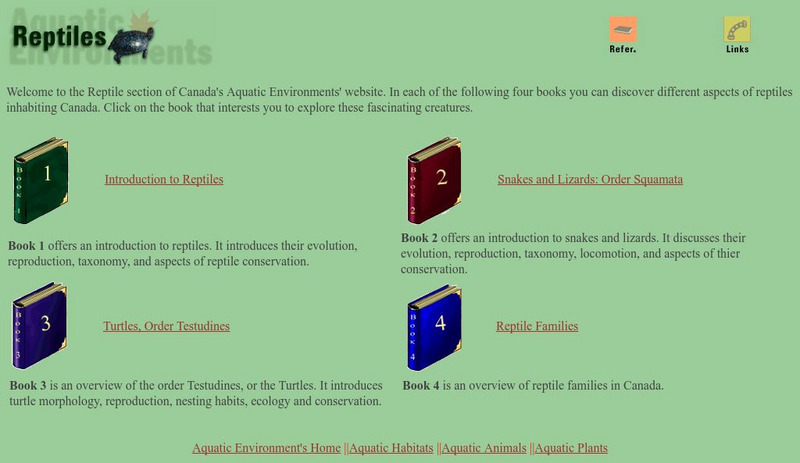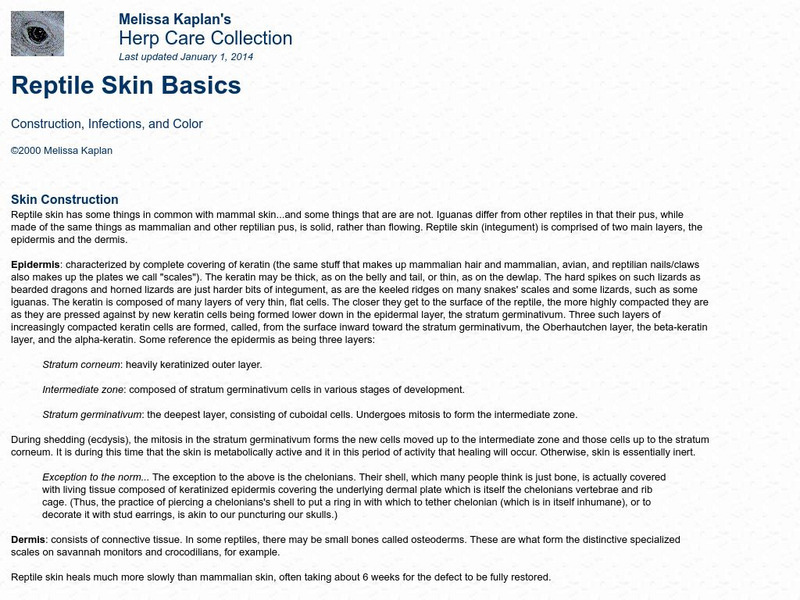Hi, what do you want to do?
Curated OER
The Missing Piece: A Tale of a Tail
Students analyze and write about their findings of the dinosaur discoveries of Edward Cope. In this Edward Cope lesson plan, students examine illustrations of concept maps, discuss challenges, analyze skeleton diagrams, and write...
Curated OER
Amphibian Spawns
Students observe tadpoles as they gradually change into adults. In this amphibian biology lesson plan, students watch tadpoles in a tank in the classroom, keep a daily record of what they observe, and chart the growth development...
Curated OER
The Froggy Page
Students investigate the cycle of life by observing tadpoles. In this biology lesson, students utilize the Internet to read stories, observe pictures, and listen to sounds of frogs. Students create a poster board collage...
Curated OER
What's Wild
Third graders discover the differences between wild and domestic animals. In this animal lesson, 3rd graders chart the differences in the animals and look through magazines for pictures of wild and domestic animals to glue to a poster....
Curated OER
Kids for Conservation: Animal Unit
Young scholars discuss animal needs and characteristics. In this animal mini-unit, students complete three activities studying different animals, their needs, how they have evolved, and how to protect them.
Curated OER
Connecticut Wildlife: Biodiversity and Conservation Status of Our Vertebrate Populations
Young scholars explore the different types of vertebrates found in their area. In this environmental science lesson plan, students perform a case study on the Common Raven. They analyze data collected from research and create charts and...
Curated OER
Kingdom Animalia ~ A Look at the Five Major Classes
Biological taxonomy masters examine the five main classes under phylum chordata. Pupils compare and contrast the identifying characteristics of the various organisms. They explain why taxonomy is important in classifying organisms. You...
Curated OER
A Planet Full of Animals
Students study animals and practice classifying them through observation activities. In this animal classification lesson plan, students complete a KWL chart about animals. Students then sort pictures of animals into chart categories...
Curated OER
Night Hike
Students explore Upham Woods at night and investigate about the special adaptations of nocturnal animals. They identify three nocturnal animals and how they are adapted to the night. Students explain what night vision is and how it works.
Curated OER
Identifying Dinosaurs
Students investigate basic information about dinosaurs. They listen to the book, "My Visit To the Dinosaurs," explore various websites, take an online quiz, and play an online dinosaur game.
Curated OER
Learning About Classification
Students explore the three main organismal divisions. Students classify organisms by invertebrates, vertebrates, and plants. They observe the differences and similarities between these groups.
Curated OER
Personal Learning Profile
Students investigate the life of Ghandi in order to find out how they learn. The choice of Ghandi was made because many students are not familar with him. Then student engage in different modalities of learning and take learning style...
Curated OER
Color Crazy
First graders create their own brightly colored animals. In this animal adaptations lesson, 1st graders create an animal that is brightly colored but can blend into it's environment.
Curated OER
Nature Art Exploration
Students draw a nature landscape using watercolors. In this life science lesson, students share their personal experience on the beauty of nature. They create clay models of different native animals.
Curated OER
Learn About Dinosaurs
Students read facts about dinosaurs and then participate in a variety of dinosaur activities. In this dinosaur lesson plan, students paint dinosaur eggs, play dinosaur bingo, and more.
Curated OER
Mesozoic Sea Life Diorama
Students create a diorama depicting Mesozoic sea life. They color a template and add shells and pebbles to the diorama to depict the ocean floor.
Curated OER
Birds of Wisconsin
First graders explore the job done by ornithologists. They role play identifying the characteristics that make a bird a bird. They discuss what makes each bird species unique. Students are introduced to Wisconsin's most common and rare...
Curated OER
Wildlife Habitat
Students explain what a habitat is and describe its four elements. They see how an area's habitat suitability varies with different species of wildlife. They name factors that affect habitat suitability.
Curated OER
What Stages Do Insects Go Through?
Fourth graders observe mealworms over a period of time and record any changes they observe. They record any changes in color, length, behavior, and any other noticeable changes, identify the stages of the mealworms, and create a chart...
University of Guelph
Discover Canada's Aquatic Reptiles
Site provides users with information regarding the different aspects of reptiles inhabiting Canada. Offers links to references, snakes and lizards, turtles and reptile families.
Other
Melissa Kaplan: Reptile Skin Basis
A good introduction to the skin of reptiles. Describes some of the general characteristics of the scales. Information on various diseases is included. Also links to many related articles are listed.
University of California
Ucmp: The Tyrant Lizards: The Tyrannosauridae
This site from the University of California provides basic information on T. rex with links to related material great for a quick introduction.
Science Education Resource Center at Carleton College
Serc: Investigating Classification: Minnesota Vertebrates
This activity serves as an introduction to classification. The students will place animals into its proper vertebrate group according to certain characteristics that the animals have in common.



























